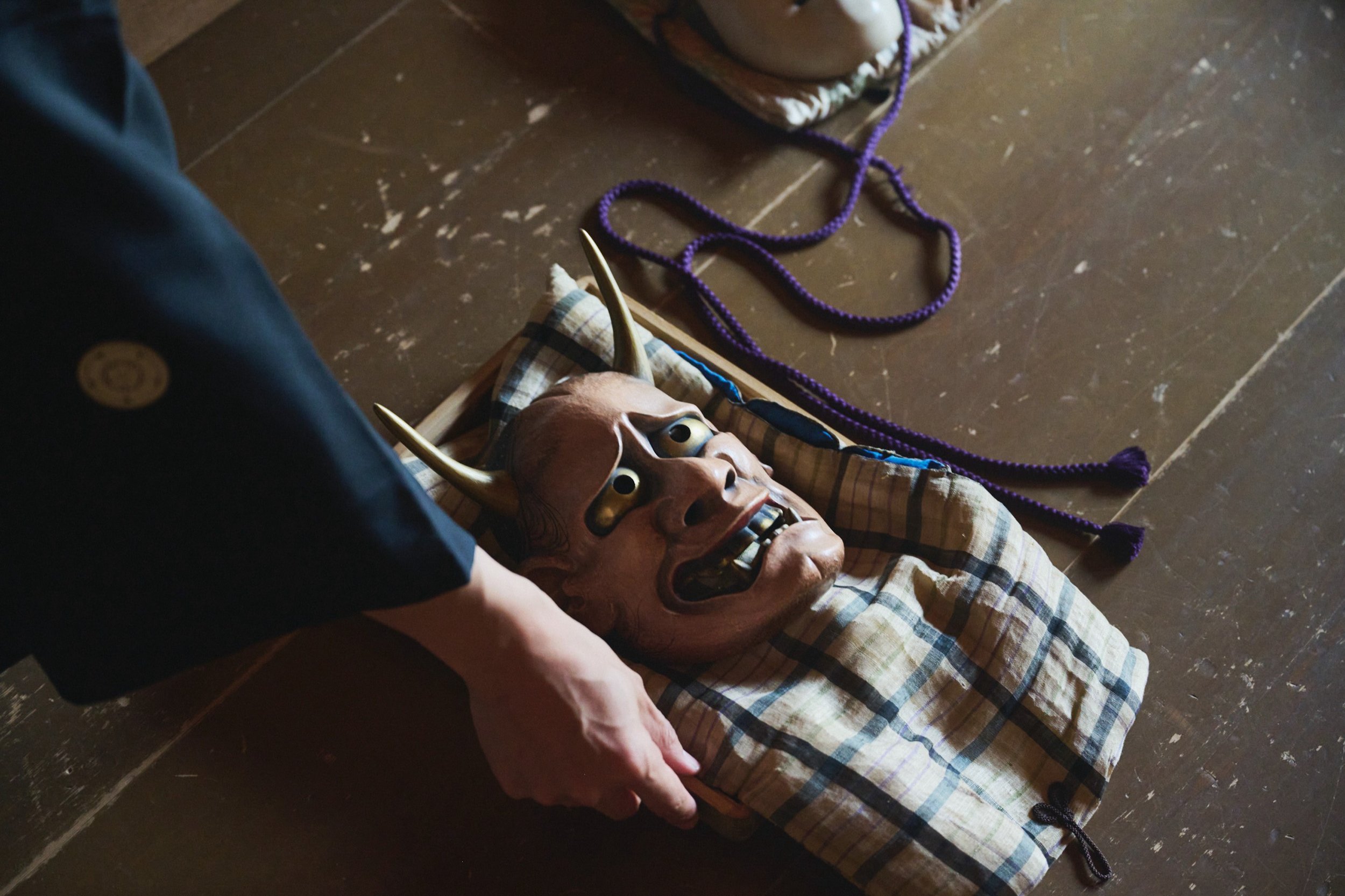To Become Another: The Mask in Japanese Culture
By David McElhinney
Picture a Japanese mask. What images spring to mind?
Perhaps it’s an oni mask, all contorted features and fanged teeth, or a blood-red tengu mask with its Pinocchio-like nose. Maybe it’s the horned helm of the samurai, hewn into the likeness of a mythological creature, or the red and blue namahage mask donned for one of Japan’s most uninterpretable folk rituals. There are the masks of Noh, Kabuki, and Kagura theater, of superheroes like Ultraman and the Kamen Riders, and the surgical face coverings universally adopted in Japan during the Covid years.
Masks are commonplace, yes. But is there more to this tradition than mere aesthetic or practical value? Semiotic reasoning suggests the mask is both an ever-present known quantity – existing in cultures across the world, with clear forms and functions – and also a bit of an enigma, because the line between what the mask giveth and what the mask taketh is blurred.
Nowhere is this more pronounced than in Japan, where the mask is an overt display of national craft heritage and spiritual practices, of the country’s attention to artistic detail and its approach to storytelling. But it also represents an innate Japanese philosophy – something intangible and abstract and clouded by its own mythos – dictating how individuals should act upon the world. The mask in Japan has many iterations; in fact, it has penetrated almost every sphere of social life.
The Origins of the Japanese Mask
The oldest known masks in Japan are from the Jomon period, an era of prehistory that lasted from 14,000 to 300 BC when the archipelago was populated by disparate tribes of semi-organized hunter-gatherers. Made mostly from clay, with a handful of recovered masks crafted from stone or shells, they were likely prized for their ornamental value or worn during rituals and ceremonies. In many cases these ancient masks were small – no wider than 11 cm – so they may have been affixed to the forehead, rather than covering the entire face.
Prior to the eighth-century Nara period, when Japan’s oldest extant texts were written, understanding how masks were used is mostly guesswork. But around this time, Gigaku, a theatrical style that literally translates to “skilled music,” was introduced to Japan by Buddhist travelers from present-day Korea. The fourteen principal characters of Gigaku theater were depicted using wooden masks, such as Karura, a bird-humanoid god; the wrestlers Kongo and Rikishi, who represented the Nio guardians from Buddhist lore; and Shishi, leonine creatures from Chinese myth.
These Gigaku masks would go on to influence other theatrical styles – most notably Noh – and were also used to inject comic levity into solemn Buddhist rituals and to situate the art and performance above the actor, rendering the human behind the mask anonymous. At a time when ideas like the dissolution of the self and foregoing the pursuit of gratification were proliferating across the archipelago, the mask became a reflection of Buddhist philosophy.
During the Heian years (794-1185), Japan was also moving towards a more formalized, structured society with a shared sense of what it meant to be Japanese. This fostered collectivism and group-oriented thinking; a social landscape in which standing out from the crowd was decried rather than valued. The mask, therefore, allowed its wearer to fulfill a role while they remained as inconspicuous as a single grain of rice in a soon-to-be-harvested paddy.
The Evolution of the Japanese Mask
The evolution of masks in Japan is more a family tree than a linear path. Gigaku gave rise to Bugaku and Dengaku, theatrical dance performances that included their own masked characters, like dragons, phoenixes, and Hyottoko, a colorful court jester who sometimes doubled up as the god of fire. Kagura, meaning “entertaining the gods,” was borne out of Shinto ritual and is mentioned in the eighth-century Nihon Shoki (The Chronicles of Japan). It was likely performed at shrines and the imperial court during the Heian period, featuring masked renderings of Ebisu, the god of fishermen; Susano-o, an impetuous and occasionally heroic member of the Shinto pantheon; and Orochi, the eight-headed serpent. Some argue that tengu masks, or something that resembled them, also originated at this time, when nobles would wear them to festivals and events to conceal their identities, much like aristocrats attending a Venetian masquerade ball.
Elaborate samurai masks appeared during the Kamakura period (1185-1333), as the warrior class became more influential under the rule of Japan’s first shogunate. Carved into snarling animal faces or demonic creatures, they were designed to instill fear in the enemy and offer protection against projectiles and whirring katana swords. Japan’s most famous masked mercenaries, the shinobi, or ninja, might not have been as prominent as fictional tales would imply, but they did play a warfare role in the feudal age, dealing in sabotage, stealth and tactical espionage. The ninja weren’t always wreathed black, either, but disguising oneself as an itinerant monk or nameless peasant was part of the trade.
The styles of mask, and the materials used to create them, branched farther and wider in the Edo period (1603-1868) when the country entered a sustained period of peace and the arts and culture blossomed in lockstep. Masks depicting demons, porcelain-skinned women, kitsune (fox messengers of the god Inari), and kappa (amphibious imps from local folklore), were used for the growing number of cultural festivals and live storytelling performances. Some of these events, like Namahage in Akita Prefecture, continue today. First recorded by writer and diarist Masumi Sugae in his early-19th-century travelogue, Oga no Samukaze (The Cold Wind of Oga), the Namahage tradition features masked men storming through homes on the Oga Peninsula on New Year’s Eve hunting for misbehaved children. It grew into such a cultural phenomenon that locals established the Namahage Sedo Festival in 1964 to accommodate enquiring tourists.
Wood was, and still is, one of the primary mask crafting materials in Japan, but some artisans preferred clay, lacquered metal, leather, or papier-mâché using kozo (mulberry) fibres. Mask makers created their own styles and techniques, fashioning molds from clay, carving masks from single pieces of cypress, experimenting with different types of natural paint, or using washi paper covered in persimmon extract to ward off ravenous insects.
Japan is also associated with the use of “surgical” masks, woven face coverings often worn during flu and hay fever seasons that became ubiquitous during the COVID pandemic. But even the origins of this style of mask are more ancient than you might think. Attendees at Edo-period religious rituals often donned sakaki leaves (Japanese ternstroemia) to prevent despoiling the air – a custom still observed at some shrines and temples. Proto-surgical masks were then used in clinics and mines in the early-1800s, and with the Spanish flu pandemic of 1918-20, the citizenry adopted them en masse. This was bolstered by a booming industrial economy, meaning Japan was able to produce masks quickly and efficiently, and the nation’s renewed imperial ambitions which reduced every individual to a subject in service of the emperor. Wearing a mask in times of disease or during a public health crisis became a form of patriotic duty, a symbol of those who were selfless versus those who were self-serving. It also became a question of conformity, as people wore masks to fit in and adhere to public ideals, rather than strictly as a personal choice influenced by science and statistics.
Hiding Behind the Mask
In James Clavell’s sweeping work of historical fiction, Shogun, he rephrased 17th-century Jesuit priest João Rodrigues’s critique of the Japanese to form the philosophy of the three hearts:
“It's a saying they have, that a man has a false heart in his mouth for the world to see, another in his breast to show to his special friends and his family, and the real one, the true one, the secret one, which is never known to anyone except to himself alone, hidden only God knows where.”
Here Clavell touches on the concepts of tatemae (建前) and honne (本音), literally “built in-front” and “true sound,” respectively, two fundamental aspects of Japanese communication and public discourse. This conflict between “one’s stated intentions” and “one’s true meaning,” sets the mask on shifting sands; it need not have physical properties, when the metaphorical mask can fulfill a similar role.
“A mask functions simultaneously to conceal an identity and reveal, evoke, or create another,” wrote Paulo M. Barroso in his essay, The Semiotics of the Mask. “The mask represents, but it mainly transforms. It affirms and denies; it is a presence and an absence. Putting on a mask is a metamorphose; it transforms how a person becomes visible/invisible. This transformation fascinates and disturbs.”
In Japan, it is often said that the nail which sticks out gets hammered down. The sociocultural milieu that gave rise to this maxim also created the tatemae mask; the mask that conceals one’s feelings to maintain a sense of wa, the harmonious public order, ensuring the wellbeing of the group supersedes the wellbeing of the individual.
But perhaps just as the mask acts as an invisibility cloak, so too can it be an agent of empowering transformation. Maybe it even has a quasi-natural element, as though the Japanese face has evolved to fit comfortably behind the mask, much as Junichiro Tanizaki once wondered if his people were suited to the comfort of shadow and the flicker of candlelight. Through a Western lens, it might seem strange to see people don the mask with such alacrity, to see them become another so unquestionably. But in Japan it’s the quotidian condition of social life. The false heart in the mouth for all the world to see.
About the Author: David is a Northern Irish freelance journalist, writer and occasional editor based in Tokyo and the UK. Fusing reporting and social commentary with extensive experience traveling throughout the country, he has published stories on travel, arts and culture, politics and current affairs, and sports in Japan. His work has appeared in a range of national and international publications online and in print. You can find links to his work at www.davidmcelhinney.com.








